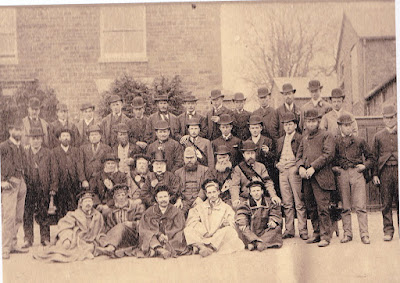This story continues on my blog Grandma Daily
ORDINARY PEOPLE is the history of an ordinary family, their loves, losses, failures and successes.
The 1901 census finds Mary Elizabeth Green and her six children in Northampton, England. They were living in a Victorian house built like many others to house the workers in the recently established surrounding clothing and shoe factories .The industrial revolution came late to Northampton ,previously most work was done at home but the invention of the Singer Sewing Machine changed the speed and ease with which boots and shoes could be stitched. Mary named the house Parammatta ,a suburb of Sydney in memory of the time they spent in Australia.
From this house Jimmy worked as a tailor, Mary as a forewoman in a shirt factory Henrietta as a shirt cutter, and Aggie as clerk in the shirt factory. Their father had trained them well and their skills enabled them to find work and flourish. In 1902 the factory girls sent Mary a letter of appreciation .
Ordinary People
Who is Who and Where they lived
Most of us remember their grandparents and aged relatives rambling on about their childhood and experiences of war ,deprivation and moments of hilarity. My grandparents and parents certainly did . This shared past was not about famous people but ordinary men and women who had gathered together in one town ,Northampton because of the economic changes and life choices that had forced them to make decisions that enabled them to earn a living .
My collection of photographs and letters are the best archive I can hope to have and I do urge anyone reading this not to take their old photos to the tip or destroy letters from the past .They are your history .
This blog will look at the value of using old photos and letters and researching around them to find how ordinary people shaped my history and can help you to investigate yours.
Over the years I have built up a large family tree but this tree puts dates and context to the names and faces in the photographs.
In 1885 my great grandparents James Green and his wife Elizabeth were living in Coventry and working as a tailors. They had three children Jimmy, Aggie and Henrietta .Life was hard, the industrial boom of the early Victorian years was over ,loss of respectability and the work house constant threats. Encouraged by the highly coloured statements of emigration touts they were induced with assisted passages to try their luck down under in Australia.
Mary Elizabeth had her photograph taken before they left .This costume showed off their tailoring skills supported by a painfully tight corset underneath.
After a long sea voyage they arrived in Newcastle, Australia, New South Wales eventually settling down in Adamstown. They set up a tailor's store , making working clothes for other immigrants. They had four more children ,Willie, Kitty ,Nellie and Julia .The children learned to cut fabric and sew. They went to a local school, Henrietta was a bright little girl , her photo was taken as the only girl to win a prize.
After ten years of everyone working hard , they made enough money for a visit home to England in 1894 .But tragedy struck when their youngest child, Julia, became ill and died suddenly .Shocked by this loss they buried little Julia in London Road Cemetery in Coventry and returned to Australia to carry on.
On their return they were photographed outside their shop.
 |
| James Green, Jimmy, Henrietta and Aggie, Mary Elizabeth, Willie , Kittie and Nellie above. |
 |
| The Friendly Society |
It is likely that the Society helped Mary to sell the business pay for the long voyage back home to England accompanied by her six children and with James' body on board The Augusta . They could only afford the cheapest berths near the boilers where they were constantly covered in smoke and soot. On arrival home James body was interred in the same grave as Julia. Their colonial adventure was over .Mary's priority was to find her family employment and avoid the workhouse.
This story continues on my blog Grandma Daily grandmadaily.blogspot.com